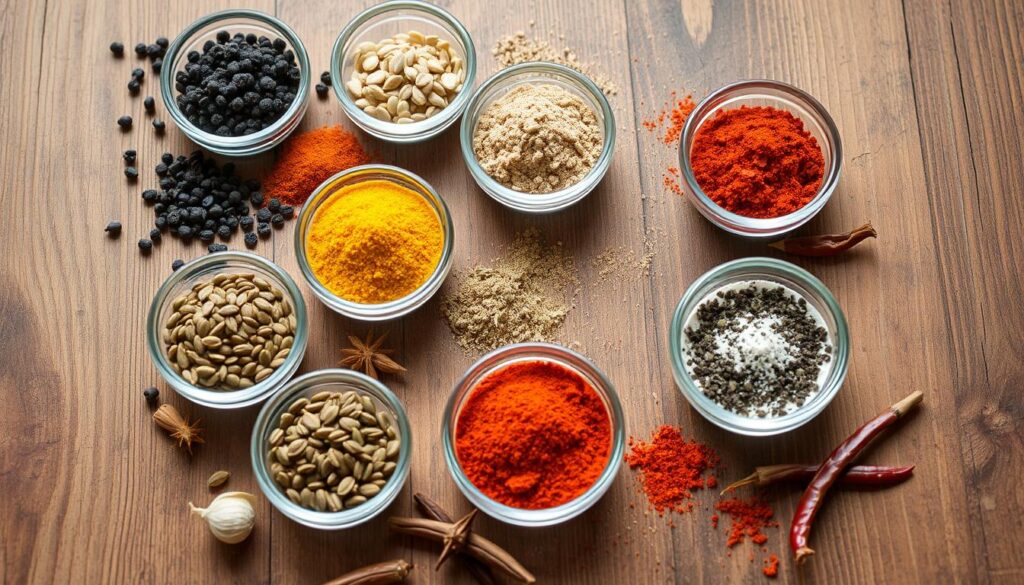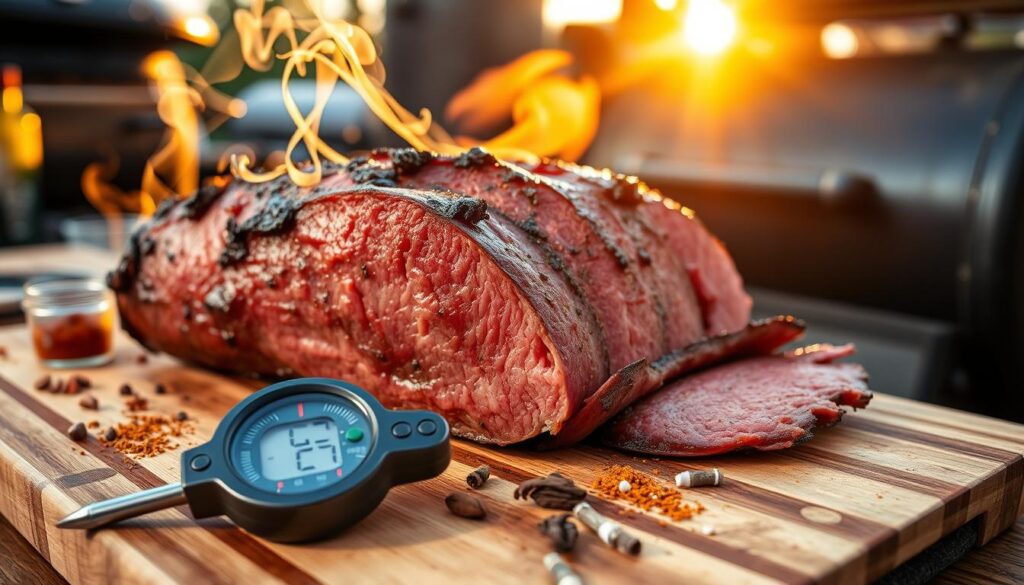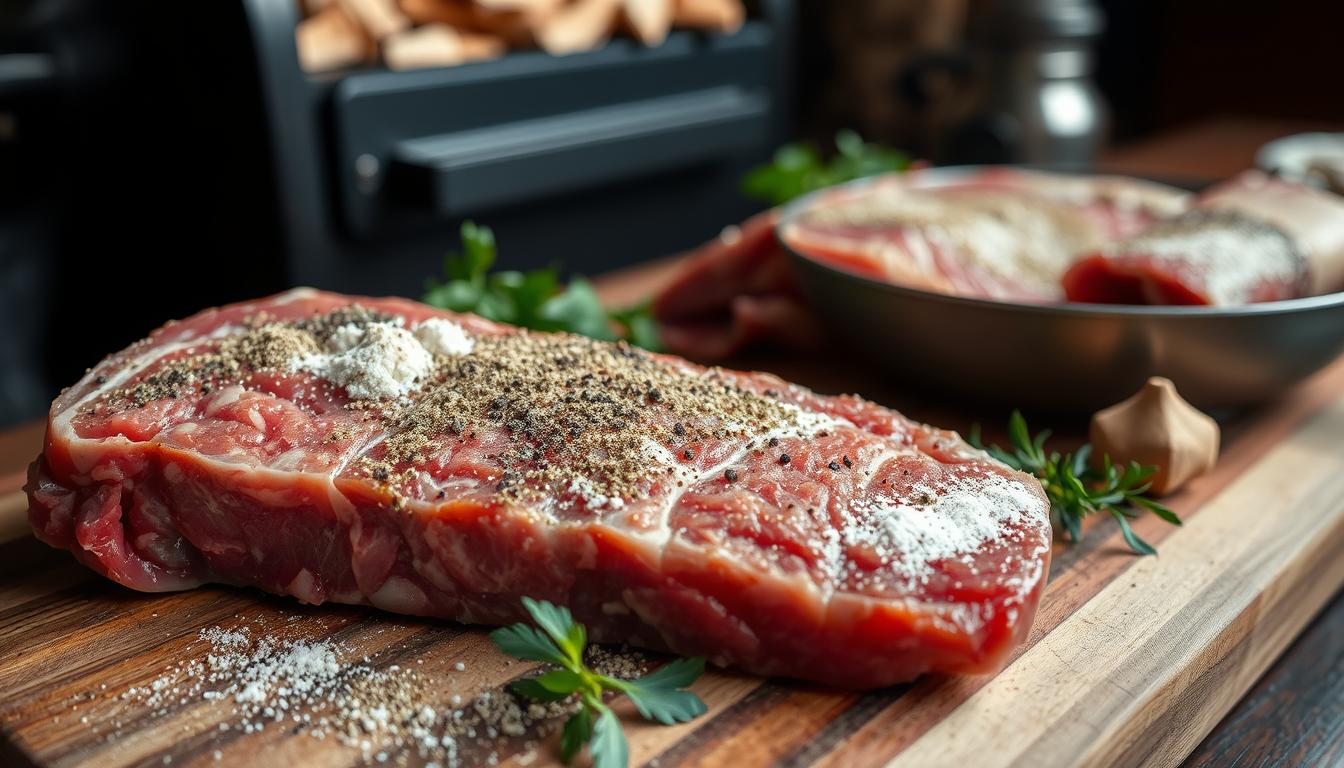The smell of smoked beef pastrami brings back happy memories from my childhood. Those flavorful slices of rye bread took me to a magical world. Now, I’m eager to teach you how to make this Jewish cuisine classic at home.
Making perfect cured meat is an art that needs patience, precision, and passion. Whether you’re cooking at home or love barbecue, mastering smoked beef pastrami will boost your cooking skills. It will also wow anyone who loves deli sandwiches.
Preparing pastrami is more than just cooking; it’s a journey. From choosing the right brisket to mastering the smoking process, every step is important. It’s about creating a delicious dish that honors tradition and modern cooking.
Key Takeaways
- Pastrami requires at least eight days from start to finish
- Brisket point cut provides the most flavorful results
- Precise curing and smoking temperatures are critical
- Proper spice blend defines authentic pastrami taste
- Slicing against the grain ensures maximum tenderness
Understanding the Art of Pastrami Making
Pastrami is a key part of Jewish deli culture. It turns simple beef into a tasty treat through careful making. This method started as a way for immigrants to preserve food and has become a favorite in American restaurants.
The story of pastrami starts with its cultural roots. Jewish immigrants from Romania and Eastern Europe brought this method to the U.S. in the late 1800s. It became a unique cooking style found in delis all over the country.
Origins of Jewish Deli Traditions
Jewish delis were places where people came together. They kept the flavors of old-world recipes alive. Making pastrami became an art, with each family and area having its way of curing and smoking beef.
Pastrami vs. Corned Beef
Even though both start with brined brisket, pastrami, and corned beef are quite different:
- Corned beef is boiled after curing
- Pastrami is smoked after curing
- Pastrami uses the fattier navel end of the brisket
- Pastrami gets a special spice rub before smoking
Traditional and Modern Preparation Methods
Traditional pastrami making takes days. Modern ways have made it quicker, but the true flavor comes from patience and sticking to the old ways.
“Pastrami isn’t just food; it’s a cherished cultural tradition passed down through generations.”
Whether you cook at home or are a pro chef, learning about pastrami making will improve your cooking. It connects you to a rich food heritage.
Selecting the Perfect Cut of Beef
Creating amazing pastrami begins with picking the right beef brisket. Not all cuts are the same. Knowing the differences can make your smoked meat truly special.
When looking for the perfect beef brisket, focus on two main cuts: the navel cut and the point cut. The navel cut, found at the brisket’s lower part, is the top choice for pastrami. It has lots of marbling and a thick fat cap, making it tender and juicy.
“The secret to great pastrami lies in selecting a cut with exceptional marbling and fat content.” – Pit Master’s Wisdom
Understanding Beef Brisket Cuts
- Navel Cut: Premium choice for pastrami
- More fat content
- Enhanced flavor profile
- Superior tenderness
- Point Cut: Excellent alternative
- Good marbling
- Slightly leaner than navel cut
- Stil delivers fantastic results
When picking your beef brisket, keep these tips in mind:
- Look for USDA grades: Prime, Choice, or Select
- Check for consistent marbling throughout the meat
- Ensure a substantial fat cap for moisture retention
- Ask your butcher about specific navel or point-cut recommendations
Pro tip: If possible, ask for a cut with at least 1/4 inch of external fat. This fat layer keeps your pastrami moist during the long smoking time.
Essential Brining Techniques for Smoked Beef Pastrami
Brining turns regular beef into a tasty pastrami. It uses special ingredients and techniques for great flavor and texture.
Curing Salt: The Secret Ingredient
Curing salt is key for real pastrami. It does several important things:
- Prevents bacterial growth
- Enhances meat color
- Develops distinctive flavor profile
- Ensures food safety during curing
Mastering the Brining Process
For the best-brined beef, follow these tips:
- Use a salt concentration of 2.5%
- Prepare brine quantity 0.5-1.0 times the meat weight
- Calculate nitrite (Prague Powder #1) at 0.0025 times the total weight
- Consider meat thickness when determining curing time
“Brining is a craft that demands both precision and patience.” – Charcuterie Expert
Understanding Desalination
Desalination is key for pastrami. It involves soaking the brined meat in fresh water to remove excess salt. This prevents the final product from being too salty.
Soak the meat for 3-4 hours in cold water. Change the water often to effectively lower the salt level.
Experts say to store the cured meat airtight and cold (below 6°C). This stops bacterial growth and keeps the flavor and texture perfect.
Perfect Spice Blend Creation
Making the perfect pastrami spice rub is like turning ordinary beef into a flavorful masterpiece. Your homemade pastrami will burst with flavor thanks to a special spice mix. This mix gives it that famous crust and deep taste.

The base of a great pastrami spice rub is coriander and black pepper. These spices are the heart of a traditional pastrami flavor. They make your meat taste authentic and amazing.
Essential Spice Blend Components
- 2 tablespoons ground coriander
- 2 tablespoons coarse ground black pepper
- 1 tablespoon mustard powder
- 1 tablespoon garlic powder
- 1 tablespoon smoked paprika
- 2 tablespoons brown sugar
“The secret to great pastrami is in the spice rub – it’s what gives the meat its soul.” – Deli Master
Here are some tips for making your pastrami spice rub. Use whole spice seeds and crack them for more flavor. Ground spices are okay too, but use less to avoid overpowering the meat.
Storage and Usage
You can store your homemade pastrami spice rub in an airtight container for months. To enjoy the best flavor, consume it within a few weeks. It’s perfect for a 9-12 pound beef brisket.
Remember, the magic happens when you coat your brined meat with this spice blend before smoking. This creates the signature pastrami crust. It will have everyone wanting your secret recipe.
Mastering the Smoking Process
Smoking pastrami is an art that turns simple meat into a flavorful delight. The right techniques can make your pastrami truly special. It becomes a dish that will wow even the pickiest eaters.
Choosing the right wood chips is key for a great smoke ring and flavor. Different woods give your pastrami unique tastes:
- Alder: Mild and delicate flavor
- Maple: Sweet and subtle smoke
- Cherry: Fruity and light taste
- Hickory: Strong and classic smoky essence
Wood Selection Guidelines
The wood chips you pick greatly affect your pastrami’s taste. Experts say mixing woods is best for a rich flavor. Avoid using too strong a smoke to not overpower the meat.
Temperature Control Methods
Keeping the temperature steady is vital for smoking. Aim for 225-240°F. This ensures the meat cooks well and soaks up lots of flavor from the wood.
Smoke Ring Development
The smoke ring forms early in smoking, when the meat is under 140°F. To get the most smoke, close the smoker’s vent for the first hour.
“The secret to great pastrami lies in patience and precision during the smoking process.” – Pitmaster’s Wisdom
Smoking pastrami is a labor of love. It needs attention to detail and a love for making great food.
Temperature Management and Timing
Getting the internal temperature right is key when smoking beef pastrami. The time you cook it affects its texture and taste. Being precise is essential during this important step.

- Initial smoker temperature: 225-240°F
- Target internal temperature: 165°F (initial checkpoint)
- Final cooking temperature: 202°F
Smoking meat needs a close watch. Keep an eye on your meat’s internal temperature all the time. A digital meat thermometer is your top ally here.
“Mastering temperature control is what elevates good pastrami to great pastrami.” – Professional Pit Master
When your pastrami hits 165°F, wrap it in foil or butcher paper. This keeps it moist and cooks it softly.
| Stage | Temperature | Cooking Duration |
|---|---|---|
| Initial Smoking | 225-240°F | 3-4 hours |
| Internal Temperature Checkpoint | 165°F | Approximately 4-6 hours |
| Final Cooking | 202°F | 1-2 additional hours |
Patience is what turns good meat into amazing pastrami. Let it cook slowly and steadily. This way, it becomes tender and full of flavor.
The Art of Steaming and Wrapping
To make your smoked beef into a tasty treat, you need to learn how to steam and wrap it right. These steps can turn your pastrami into something truly special.
Delis all over the U.S. know how to make great pastrami. Places like Katz’s Delicatessen in New York and Langer’s Delicatessen in Los Angeles show us how important steaming is. It makes the meat tender and juicy.
Steam Temperature Control
Keeping the steam temperature just right is key. It helps keep the meat moist and soft. Here’s what experts say:
- Keep the steam at 212°F consistently
- Use a steamer or oven setup
- Watch the meat’s internal temperature closely
Wrapping Techniques
The right wrapping can make a big difference in your pastrami’s quality. Pitmasters recommend:
- Choose unlined, unwaxed butcher paper
- Wrap it loosely to let steam in
- Don’t wrap too tight to avoid squishing the meat
Final Temperature Targets
Getting the meat to the right temperature is important. It keeps it juicy and tender. Here are the targets:
| Stage | Temperature | Duration |
|---|---|---|
| Smoking | 190°F | 6-8 hours |
| Steaming | 204°F | 2-3 hours |
“Steaming is the secret weapon that transforms good pastrami into a mouthwatering masterpiece.” – Chef Michael Klein
By mastering steaming and wrapping, you can make pastrami that’s as good as the best in the country.
Proper Resting and Slicing Methods
Resting meat is key to making perfect pastrami. Many home cooks miss this step. After smoking, patience is what makes the meat tender and flavorful.
Don’t slice your smoked beef pastrami right away. Let it rest for 30-60 minutes. This lets the juices spread evenly, making each slice juicy and full of flavor.
“The difference between good and great pastrami is often in the resting time.” – Deli Meat Experts
Slicing Pastrami: Essential Techniques
- Opt for a sharp knife featuring a long, slender blade
- Always slice against the grain
- Cut thin slices approximately 1/8 to 1/4 inch thick
- Maintain consistent slice thickness for uniform texture
Professional chefs say a deli meat slicer is best for precise cuts. But, a sharp carving knife works great in a home kitchen.
| Slicing Method | Ideal Thickness | Recommended Tool |
|---|---|---|
| Hand Slicing | 1/8 inch | Sharp Carving Knife |
| Deli Slicer | Adjustable 1/8-1/4 inch | Electric Meat Slicer |
Learning to rest and slice pastrami right can turn your homemade smoked meat into something amazing.
Storage and Preservation Tips
Keeping your smoked pastrami fresh is key. The right storage methods help keep its great taste and texture for longer.
Refrigeration is your best friend for up to 5 days. Here are some tips to keep it fresh:
- Wrap the pastrami tightly in butcher paper or plastic wrap
- Store in the coldest part of your refrigerator
- Keep the temperature between 32°F and 40°F
Freezing is another great way to keep it longer. Here’s how to do it right:
- Slice the pastrami into portion-sized pieces before freezing
- Use vacuum-sealed bags to prevent freezer burn
- Store at temperatures below 0°F for maximum preservation
“Storing your homemade pastrami properly is essential to preserving its exceptional flavor.” – Deli Preservation Expert
When reheating frozen pastrami, thaw it slowly in the fridge. This keeps it moist and tender. Then, steam or microwave it gently to get back its juicy texture.
| Storage Method | Duration | Temperature Range |
|---|---|---|
| Refrigeration | Up to 5 days | 32°F – 40°F |
| Freezer Storage | Up to 3 months | 0°F or below |
Pro tip: Always label your stored pastrami with the date of preservation to track its freshness and ensure the best eating experience.
Conclusion
Making homemade pastrami is an art that turns simple beef into a masterpiece. It takes patience, precision, and passion. From picking the right brisket to mastering smoking, each step adds to the flavor.
When you make pastrami at home, you control every step. You can make it tender and juicy with the right seasoning. It’s all about finding the right balance of curing, spice, and smoking.
Remember, practice makes perfect with homemade pastrami. Each try will make you better at making meat. Try new spice blends and cuts of meat. Your hard work will impress everyone.
Pastrami making is more than a cooking skill. It’s a celebration of tradition and flavor. Enjoy the journey and relish the delicious outcome of your efforts.
FAQ
What distinguishes pastrami from corned beef?
What is the best cut of beef for making pastrami?
How long does it take to cure pastrami?
What spices are typically used in a pastrami rub?
Which wood works best for smoking pastrami?
How do I know when my pastrami is fully cooked?
How should I slice pastrami for the best texture?
How long can I store homemade pastrami?
Is it difficult to make pastrami at home?
Do I need special equipment to make pastrami?
What did you think of our recipe?
There are no reviews yet. Be the first one to write one.

